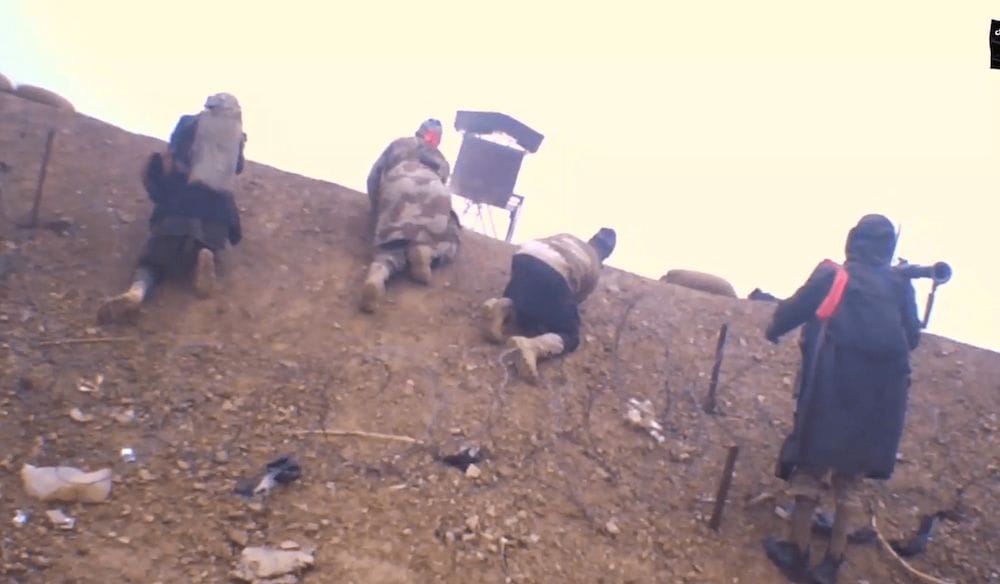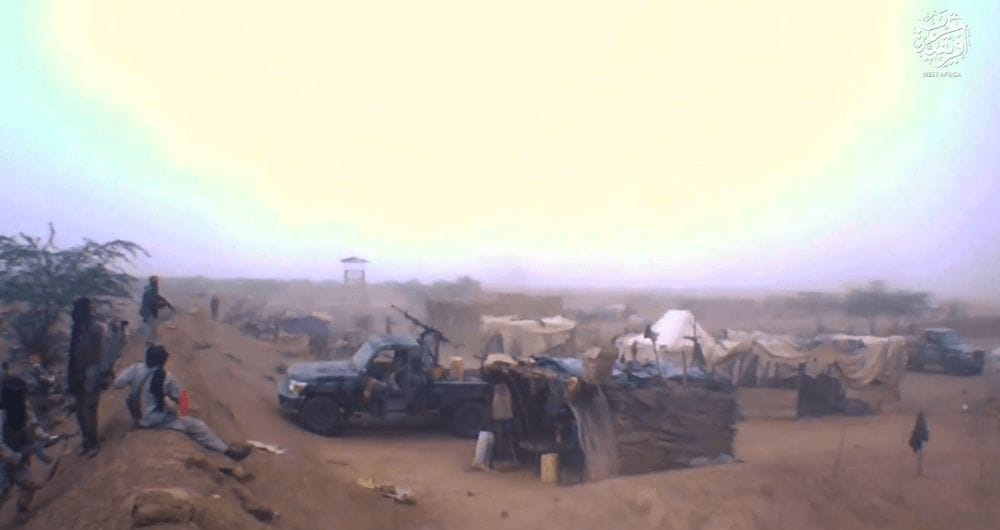Over recent years, jihadists have had a string of tactical wins against West African armies. Evidence from their attacks on Forward Operating Bases (FOBs) suggests that the ‘antifragile’ character of their tactics may provide an explanation for these successes.
According to the best-selling author Nassim Nicholas Taleb, all things fall into one of two categories. They are either ‘fragile’ or the opposite, ‘antifragile’. ‘Fragility’ need not imply weakness as the common usage of the word suggests (nor does antifragility necessarily suggest strength). Rather, a fragile thing is weakened overall by stress. Given enough time and enough stress, even the most robust thing will breakdown if it is fragile. Battleships rust, bridges eventually fail and the most hardened sea defences degenerate over decades in the face of repeated environmental stresses. In contrast, antifragile things react differently to certain (but not necessarily all) stresses. Rather than weakening, stress – especially manageable, repeated stress – strengthens things that are antifragile. The human body is a useful example. Weight training, if gradual and controlled, strengthens a person's muscles, their bones and their mental resilience (although too much, or the wrong type, has the opposite effect). This applies to human-created systems too. Ideologies, communities and institutions (including military forces) can be antifragile if they adapt to pressures in a way that makes them stronger, or fragile if they do not.
How does this relate to West African jihadists? Well, some jihadist groups in the Sahel may have developed antifragilising strategies to help them to grow. One might think that for a non-state militia, battle against state forces would prove detrimental. Versus states, we often assume that insurgents have an asymmetric power disadvantage. However, the antifragile nature of jihadist strategies may mean they grow from the stress of battle. Antifragility may thus be a less obvious advantage in favour of the jihadists that, over time, makes up for power deficiency. This identification of the antifragility of jihadist groups compliments rather than contradicts other conceptualizations of asymmetric victory such as Mack’s Interest Asymmetry Theory or Arreguín-Tofts Strategic Interaction Theory that provide insights as to why weaker parties may beat state opponents. In their interactions with jihadist groups, states may be overall powerful, but ultimately, over time, fragile. By contrast, jihadist groups may start out weak, but their antifragility means they catch up.
While jihadist groups are antifragile in a number of ways, this piece focuses in particular on the success that jihadists have had in raiding Forward Operating Bases (FOBs) manned by armies in the Sahel. From a counterinsurgency (COIN) point of view, FOBs extend power into areas where insurgents operate and reduce reaction times to their violence. In theory, while always somewhat exposed, they are supported by larger ‘Main Operating Bases’ for resupply and reinforcement. The practice of FOB use is central to contemporary counterinsurgency theory, with the tactic used across West Africa (as well as by Western forces – e.g. in Afghanistan).
Over the last decade, jihadists groups have had growing success against militaries in West Africa. A factor in this success has been the anti-fragile nature of militants’ strategies for power acquisition based on a willingness to progressively attack state forces in and around FOBs, and, over time, to use these encounters to strengthen their insurgent capacity. In Nigeria, for example, Boko Haram fighters (with the Islamic State West Africa faction today being the most prominent example) have concentrated on attacking FOBs as a means to increase their power. Interviews with security officials in Abuja highlight how fighters repeatedly strike a base over a number of days with probing attacks, forcing counter-attacks and draining local ammunition supplies in the base. Each strike is fragilising, with troops sometimes unable to be reinforced or resupplied and their ammunition levels reduced. By contrast, militant groups learn a little bit more at each attack, building up a picture of force levels. After a few days of probing attacks that strengthen them and weaken their opponents, they seek (often successfully) to seize the base.


At the level of each attack, they tip the balance in their favour each time. In these repeated attacks jihadists lose fighters and materiel (indeed they highlight deaths in their propaganda) but, if successful, the stress they have subjected themselves to in attacking the base has a big pay-off in terms of weapons and equipment captures, propaganda, training and a demoralised opposition (weapons capture is highlighted extensively in propaganda). On the matter of weapons, analysis by Calibre Obscura (here and here) discusses the scale of weapons capture from military forces in the Lake Chad region. Crucially, ISWAP picks these battles and thus the stress remains manageable. When repeated over time, and across progressively bigger bases, the insurgency develops an antifragile character – repeated and high tempo, but manageable, stress allows groups to strengthen. The group Islamic State in the Greater Sahara (ISGS), which is formally a part of ISWAP, released a video recently, that shows the groups attacks over an extended period. While further down the ‘operational ladder’ than ISWAP in Nigeria, ISGS/ISWAP appears to show a similar tactical approach and the growth in capability over time.
What might be done in the face of antifragile jihadists? There are three (likely more) potential ways that you can weaken, or at least limit, something that is antifragile. The first and most obvious is to deny it the process that allows it to strengthen over time. Take an Olympic powerlifter and ban them from the gym and they will get weaker. If the ability to create regular local asymmetries and the ensuing battles is what strengthens jihadist groups’ military capacities, deny them such encounters. This may require better defensive training, better resupply, or better base defences (videos released by ISWAP and ISGS suggest defences are a problem in some cases).
Denying them the positive effects of this stress is what Taleb refers to as via negativa. Removing a stressor from an antifragile thing will weaken it. A greater focus on secure base defences (robust 360º perimeter defenses, reinforced watch towers, prepositioned mortars and, at times, better adherence to standard operating procedures) on the part of West African armies would make them more robust and their opponents less antifragile over time.
Equally removing bases from the equation altogether could have the same effect of denying the group the stress it requires to grow. This however potentially comes at a cost to local populations unless backed up by aggressive patrols. Nigeria has done something similar with a shift to a smaller number of purportedly impenetrable of ‘supercamps’ (reinforced Main Operating Bases) in part because of the raids on FOBs. The impact of this shift on the military is yet to be seen however and, if not accompanied with patrols in the areas where former bases were located, there is a danger it may simply yield territory, populations and resources to the groups.
The second approach is to apply overwhelming stress. If we return to our powerlifter, gradual ‘progressive overload’ will encourage increased strength. However, if they suddenly try to lift double their previous maximum, major injury is likely. Just because a thing is antifragile does not mean it cannot absorb any level of stress. Unmanageable stress is fragilizing. Overwhelming force is typically the response of many militaries in the face of irregular threats. However, this may not be the best strategy. The problem is that, as experienced guerillas, West African jihadists will generally deny battle and deny the counter-insurgent the ability to apply such a decisive force. Even worse, they will encourage such a force to be applied in a way that hurts the population, bolstering support for the militants. Applying overwhelming force can work in a limited sense (c.f. Russia in Chechnya) but it often comes at an enormous and intolerable cost for civilians. The dangers of overwhelming force are also well appreciated by jihadists in the region. ISWAP in Nigeria has learnt from both Boko Haram and Islamic State’s failed efforts to hold territory. Holding ground makes it much easier for armies to apply overwhelming pressure and, for now, the group has adopted a more transient model of population control, rather than territorial control as a result.
A third approach is perhaps the most effective, but hardest: become more antifragile than your opponent. In other words, develop systems that generate more of an antifragile payoff from a violent encounter for you than from your opponents. Perhaps the most well-known example of this is General Stanley McCyrstal’s adaptation of Joint Special Operations Command (JSOC) in their fight against Al Qaeda militants in Iraq in the mid 2000s. McCrystal created a horizontal ‘team of teams’ that was highly mobile and kinetic. Some have rightly highlighted how, in so doing, the US created a ‘network to fight a network’. Equally important however was the antifragile character of the network. He integrated all aspects of missions especially intelligence exploitation and special forces teams, so that JSOC could learn and move faster than the al Qaeda cells could adapt. The US was essentially able to out-antifragilise an antifragile foe. Information dominance combined with the tactical capabilities of US special forces made for an adaptable and learning organisation. However, one should note that the US has more resources than West African states, and it faced a terrorist foe, rather than an insurgency. Nevertheless, a highly-mobile and intelligence-led approach similar to this was evidently expected to accompany the move to ‘supercamps’ in Nigeria, although the effects of this approach remain to be seen.
That these methods of dealing with an antifragile insurgency are all unpalatable or difficult to realize in the near term shows the challenge facing states in the Sahel region. Even small steps, however, could yield important results. Attention to base defense and rapid reinforcement and resupply would slow the loss of forward operating bases and the steady flow of weapons and resources to the jihadists this entails. Likewise, in Nigeria, a focus on the ability to launch rapid-response operations based on new intelligence would allow the military to increase the pressure on ISWAP and get ahead of the jihadists – adapting faster than ISWAP can. The crucial message here, however, is that attempts to contain the threat through deployment into inadequate FOBs can make the situation worse. This is not an argument against FOBs per se (nor an argument for ceding populations to the groups), but if jihadist groups are allowed to act in an antifragilising way towards FOBs, then the repeated, but manageable, stress of battle will strengthen them over time.
Acknowledgements
Cover photo "Harvest of barbells - Valinhos, SP" by Fábio Valinhos is licensed under CC BY-NC 2.0
